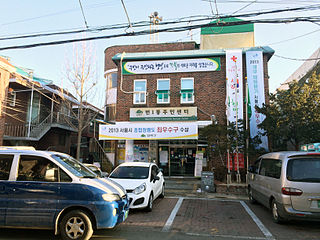
Gangbuk District is one of the 25 gu which make up the city of Seoul, South Korea. Its name is derived from it being located at the north of Han river. It was created from neighbouring Dobong District in 1995. The current mayor is Park Gyeom-su.

Jeungsan-dong is a dong (neighbourhood) of Eunpyeong-gu in Seoul, South Korea.

Nokbeon-dong is a dong, neighbourhood of Eunpyeong-gu in Seoul, South Korea.
Yeokchon-dong is a dong, neighbourhood of Eunpyeong-gu in Seoul, South Korea.

Beon-dong is a dong (neighborhood) of Gangbuk District, Seoul, South Korea.

Suyu-dong (Korean: 수유동) is a dong, neighbourhood of Gangbuk-gu in Seoul, South Korea. From June 30 of 2008, six administrative Suyu-dongs were divided to Insu-dong, Ui-dong, and Suyu-dong.
Seorin-dong is a dong (neighbourhood) of Jongno-gu in Seoul, South Korea. It is a legal dong administered under its administrative dong, Jongno 1, 2, 3, 4 ga-dong.
Jae-dong is a dong, neighbourhood of Jongno-gu in Seoul, South Korea. It is a legal dong administered under its administrative dong, Gahoe-dong.
Nusang-dong is a dong, neighbourhood of Jongno-gu in Seoul, South Korea. It is a legal dong administered under its administrative dong, Hyoja-dong.
Ogin-dong (Korean: 옥인동) is a dong (neighbourhood) of Jongno District, Seoul, South Korea. It is a legal dong, administered under its administrative dong, Hyoja-dong, of which it covers the westernmost part, until the fortress wall of Inwangsan.

Pyeongchang-dong is a dong, neighbourhood of Jongno-gu in Seoul, South Korea.
Naesu-dong is a dong, neighbourhood of Jongno-gu in Seoul, South Korea. It is a legal dong administered under its administrative dong, Sajik-dong.
Jeokseon-dong is a dong, neighbourhood of Jongno-gu in Seoul, South Korea. It is a legal dong administered under its administrative dong, Sajik-dong.
Pirun-dong is a dong, neighbourhood of Jongno-gu in Seoul, South Korea. It is a legal dong administered under its administrative dong, Sajik-dong.
Palpan-dong is a dong, neighbourhood of Jongno-gu in Seoul, South Korea. It is a legal dong administered under its administrative dong, Samcheong-dong.
Pyeong-dong is a dong, neighbourhood of Jongno-gu in Seoul, South Korea. It is a legal dong administered under its administrative dong, Gyonam-dong.
Songjung-dong is a dong, neighbourhood of Gangbuk-gu in Seoul, South Korea. From June 30 of 2008, Former Mia-4 and 9 dongs are combined for this dong.
Songcheon-dong is a dong, neighbourhood of Gangbuk-gu in Seoul, South Korea. From June 30 of 2008, Former Mia-5 and 8 dongs are combined for this dong.
Samgaksan-dong is a dong, neighbourhood of Gangbuk-gu in Seoul, South Korea. From June 30 of 2008, Former Mia-6 and 7 dongs are combined for this dong.
Samyang-dong is a dong, neighbourhood of Gangbuk-gu in Seoul, South Korea. From June 30 of 2008, Former Mia-1 and 2 dongs are combined for this dong.







